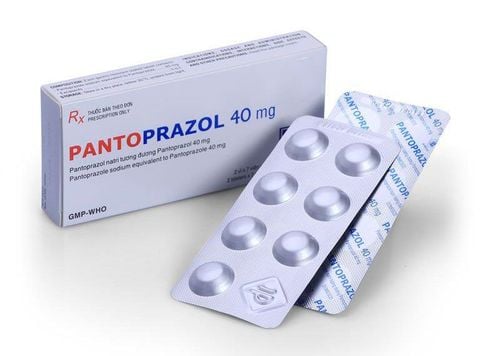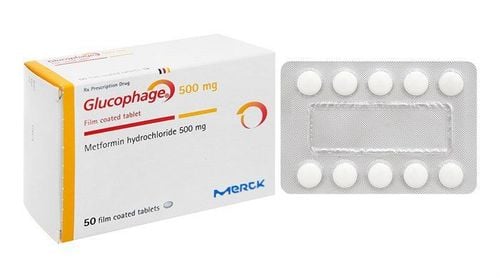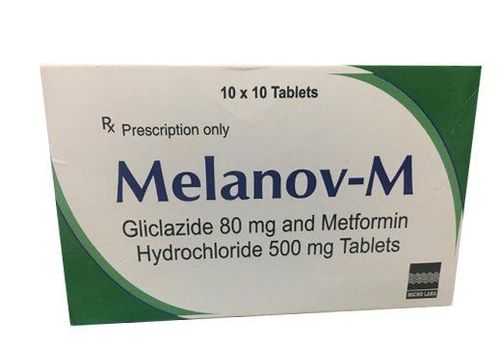This is an automatically translated article.
Vigorito is indicated as an adjunct to diet and exercise to improve glycemic control in patients with type 2 diabetes mellitus, as monotherapy or in combination.1. What is Vigorito?
Vigorito medicine has the main ingredient is Vildagliptin, the drug is made in the form of tablets with a strength of 50mg. Vildagliptin has a rapid and complete inhibition of DPP-4 activity, leading to increased endogenous fasting and postprandial concentrations of the incretin hormones GLP-1 (glucagon-like peptide 1) and GIP (secretory-stimulating polypeptide). glucose dependent insulin).By increasing endogenous levels of the hormone incretin, Vildagliptin increases the sensitivity of beta cells to glucose, leading to improved glucose-dependent insulin secretion.
Treatment with Vildagliptin 50 - mg in patients with type 2 diabetes improved markers of beta cell function including HOMA - β, the ratio of proinsulin to insulin. In people without diabetes (normal blood sugar), Vildagliptin does not stimulate insulin secretion or reduce glucose levels.
By increasing endogenous GLPT levels, Vildagliptin enhances the sensitivity of alpha cells to glucose, leading to appropriate regulation of glucagon secretion in response to glucose concentrations.
The insulin/glucagon ratio is elevated during hyperglycemia due to increased levels of the hormone incretin leading to decreased glucose production in the fasting and postprandial liver, leading to hypoglycemia.
When using Vildagliptin, there was no slow effect on gastric emptying due to increased GLP-1.
2. Uses of Vigorito 50mg
2.1. Point
Vigorito is indicated for use in the following cases:Vigorito is used as monotherapy in patients with type 2 diabetes who cannot control their blood sugar with diet and exercise, and in patients with anti-inflammatory drugs. indication or intolerance to Metfformin .
Vigorito is used in a two-drug combination:
In combination with Metformin: patients do not have adequate glycemic control despite tolerating the maximum dose of Metformin. Combination with Sulphonylurea: The patient has not controlled blood sugar despite the maximum dose of Sulphonylurea and the patient cannot use Metformin due to contraindication or intolerance. Co-administration with Thiazolidindion when Thiazolidindion does not provide adequate glycemic control in the patient. Vigorito is used in a three-drug combination: With Sulphonylurea and Metformin: when a change in diet, exercise and dual therapy with Sulphonylurea and Metformin is not sufficient for the patient's blood sugar control.
In addition, Vigorito is also indicated in combination with insulin (with or without Metformin) when diet, exercise and stable insulin doses do not provide adequate glycemic control for the patient.
2.2. Contraindications
Vigorito is contraindicated in cases of allergy or hypersensitivity to Vildagliptin or any of its ingredients.3. How to take Vigorito 50mg
Vigorito is to be taken orally with or without food.3.1. Dosage
Adults When using Vigorito alone, in combination with Thiazolidindion, in combination with metformin, in combination with Metformin and Sulphonylurea or with insulin (with or without Metformin), the recommended dose of Vigorito is 100 mg/day: 1 tablet / time x 2 times / day use in the morning and evening. When used in combination with Sulphonylurea, the recommended dose of Vigorito: 1 tablet x 1 time/day in the morning. In this group of patients, Vigorito at a dose of 100 mg/day was not more effective than a dose of 50 mg/day. In addition, a lower dose of sulphonylurea should be considered to avoid the risk of hypoglycemia. Doses of Vigorito higher than 100mg are not recommended. The efficacy and safety of Vigorito in combination with Metformin and Thiazolldindion have not been established. Children: The safety and effectiveness of Vigorito for children and adolescents under 18 years of age have not been established. Vigorito should not be used in this patient. Elderly (≥ 65 years): No dose adjustment of Vigorito 50mg is required in the elderly. Patients with renal impairment: In patients with mild renal impairment with creatinine clearance ≥ 50 ml/min, no dose adjustment is required. In patients with moderate or severe renal impairment, end-stage chronic kidney disease, the recommended dose of Vigorito is 50mg once a day. Patients with hepatic impairment: Vigorito 50mg should not be used in patients with liver failure, patients with liver enzymes ALT or AST increased 3 times the upper limit of normal.3.2. Vigorito drug overdose and treatment
Information on possible symptoms of Vildagliptin overdose was obtained from a gradually increasing dose tolerability study in healthy subjects receiving Vildagliptin for 10 days.When taking Vildagliptin 400 mg dose, some cases of myalgia, mild and transient paresthesia, fever, edema and transient increase in lipase levels occurred. Vildagliptin 600 mg dose may cause edema in the hands and feet, increased levels of creatinine phosphokinase, liver enzymes, CRP and myoglobin. All of the above symptoms resolved spontaneously after discontinuation of Vildagliptin without treatment.
Management: in case of Vildagliptin overdose, symptomatic supportive treatment is recommended. Vildagliptin is not removed by hemodialysis but the major hydrolysed metabolite of Vildagliptin (LAY 151) can be removed by hemodialysis.
4. Undesirable effects when using Vigorito
When using Vigorito 50mg, you may experience the following undesirable effects:Vigorito in combination with Metformin: Hypoglycemia, tremor, headache, dizziness, nausea or fatigue. Vigorito used in combination with Sulphonylure: Hypoglycemia, tremor, headache, dizziness, weakness, constipation. Rare: Nasopharyngitis. Vigorito used in combination with Thiazolidindion: Weight gain, peripheral edema, hypoglycemia, headache, asthenia. Monotherapy: dizziness, hypoglycemia, headache, peripheral edema, constipation, arthritis, upper respiratory tract infection, nasopharyngitis. Vigorito used in combination with Metformin and Sulphonylure: Hypoglycemia, dizziness, tremor, increased sweating, asthenia. Use in combination with insulin: Hypoglycemia, headache, chills, nausea, gastroesophageal reflux disease.
5. Note when using Vigorito 50mg
Vigorito should not be used as a substitute for insulin in patients requiring insulin. Do not use Vigorito in patients with type 1 diabetes or diabetic ketoacidosis.Renal impairment: Vigorito should be used with caution in patients with moderate or severe renal impairment.
Hepatic impairment: Contraindicated in patients with liver failure, patients with liver enzymes increased 3 times the upper limit of normal.
Monitoring liver enzymes during the use of Vigorito: There have been reports of liver dysfunction when treated with Vigorito. Symptoms usually subside and liver function tests return to normal after discontinuation of the drug. Liver function tests should be performed before using Vigorito, and monitored every 3 months for the first year of use and periodically thereafter. In patients with jaundice, liver enzymes increased 3 times the upper limit of normal, Vigorito should be discontinued. After stopping treatment with Vigorito, liver function tests return to normal, the drug should not be reintroduced.
Heart failure: a study showed that the use of Vildagliptin in patients with NYHA class I - III heart failure showed no change in left ventricular function or worsening of congestive heart failure. Clinical experience with the safety of Vildagliptin in patients with NYHA class IV heart failure is inadequate and Vildagliptin should not be used in these patients.
Skin diseases: Although an increased incidence of skin lesions has not been observed in clinical trials, experience with Vigorito in diabetic patients with skin complications is limited. In addition, there are reports of blistering and peeling of the skin after the drug was put on the market.
Acute pancreatitis: Vildagliptin may increase the risk of acute pancreatitis. Patients should be informed of the characteristic symptoms of acute pancreatitis.
If acute pancreatitis is suspected while taking Vigorito, the drug should be discontinued. If acute pancreatitis is confirmed, Vigorito should not be restarted. Use with caution in patients with a history of acute pancreatitis.
Hypoglycemia: Patients taking Vigorito in combination with Sulphonylurea are at risk of hypoglycemia. Consider a lower dose of sulphonylurea to reduce the risk of hypoglycemia.
Pregnant women: There is not enough information about the safety of using Vigorito 50mg in pregnant women, so it should not be used during pregnancy.
Lactation: It is not known whether Vildagliptin is excreted in human milk, however animal studies have shown that vildagliptin is excreted in breast milk. Vigorito 50mg should not be used in nursing women.
6. Drug interactions
Vildagliptin rarely interacts with other drugs. Vildagliptin is not a substrate of the cytochrome Piperacillin (CYP) 450 enzyme and does not inhibit or induce this enzyme. Vildagliptin therefore does not generally interact with substances that are substrates, inhibitors or inducers of CYP 450 enzymes.Digoxin, Warfarin : Studies performed in healthy subjects have shown no interactions of Vigorito with these drugs. clinically meaningful. However, no patient studies have been performed.
Amlodipine, Valsartan, Ramipril, Simvastatin: Studies in healthy subjects have shown no clinically significant interactions of Vigorito with these drugs when co-administered.
ACE inhibitors: Increased risk of angioedema in patients taking Vildagliptin and ACE inhibitors.
The hypoglycemic effect of Vildagliptin can be reduced by some substances such as Corticosteroids, Thiazides, Thyroid preparations and sympathomimetic agents.
Please dial HOTLINE for more information or register for an appointment HERE. Download MyVinmec app to make appointments faster and to manage your bookings easily.













